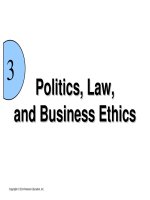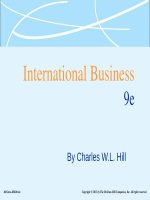Lecture International business (11/e) - Chapter 17: Export and import practices
Bạn đang xem bản rút gọn của tài liệu. Xem và tải ngay bản đầy đủ của tài liệu tại đây (424.4 KB, 38 trang )
chapter seventeen
Export and Import Practices
McGrawHill/Irwin
International Business, 11/e
Copyright © 2008 The McGrawHill Companies, Inc. All rights reserved.
Learning Objectives
Explain why firms export and problem areas of
exporting
Identify the sources of export counseling and support
Discuss the meaning of the various terms of sale
17-3
Learning Objectives
Identify some sources of export financing
Describe the activities of a foreign freight forwarder
Understand the kinds of export documents required
Identify import sources
Explain the Harmonized Tariff Schedule of the United
States (HTSUSA)
17-4
Why Export?
• Reasons to export
– To serve markets where the firm has no or
limited production facilities
– To satisfy a host government’s requirement
that the local subsidiary have exports
– To remain price-competitive in the home
market
– To test foreign markets and foreign
competition inexpensively
17-5
Reasons to export?
cont’d.
– To offset domestic market’s cyclical sales
– To achieve additional sales
– To extend a product’s life cycle
– To respond strategically to foreign
competitors
– To achieve the success the firm’s
management has seen others achieve
– To improve the efficiency of manufacturing
equipment
17-6
Reasons not to Export
• Two major reasons
– Preoccupation with the vast American
market
– Reluctance to become involved in a new,
unknown and therefore risky operation
• Not active in international markets due to
– Lack of knowledge
• Locating foreign markets
• Payment and financing procedures
• Export procedures
17-7
Sources of Export Counseling
• Trade Information Center (TIC)
– The federal government has to set this up as a first
stop for information
– Visit />
• International Trade Administration (ITA)
– Offers a wide range of export promotion activities
that include
• Market Access and Compliance (MAC)
• Trade Development
• U.S. and Foreign Commercial Services
(US&FCS)
17-8
Sources of Export Counseling
• Small Business Administration (SBA)
– The office of International Trade of the SBA
works through
• Small Business Administration offices
• Score Program
• Small Business Development Centers
• Centers for International Business
Education and Research (CIBERs)
17-9
Show and Sell
• Trade events to facilitate international
trade
– U.S. pavilions
– Trade missions
– Product literature center
– Reverse trade missions
17-10
Export Marketing Plan
• Essentially same as domestic marketing
plan
• Specific about
– Markets to be developed
– Marketing strategy for serving them
– Tactics to make the strategy operational
17-11
Terms of Sale
• INCOTERMS
– Universal trade terminology developed by
the International Chamber of Commerce
– Ex-Works
• Risk passes at factory door
• US equivalent: FOB (free on board)
17-12
Terms of Sale, cont’d.
– FAS
• Free alongside ship, port of call
– CIF
• Cost, insurance, freight, foreign port
– CFR
• cost and freight, foreign port
– DAF
• Delivered at frontier
17-13
Payment Procedures
• Payment terms offered by exporters to
foreign buyers
– Cash in advance
• When credit standing of the buyer unknown or
uncertain
– Open account
• When sale is made on open account
– Seller assumes payment risk
– Offered to reliable customers in economically
stable countries
17-14
Payment Procedures, cont’d.
– Consignment
• Goods shipped to buyer; payment made when
sold
• Payment risk assumed by seller
– Letter of credit (L/C)
• Document issued by buyer’s bank
– Promise to pay seller specified amount
when bank has received documents
stipulated in letter of credit
17-15
Payment Procedures, cont’d.
• Letter of credit
• Confirmed L/C
– Correspondent bank in seller’s country
agrees to honor issuing bank’s L/C
• Irrevocable L/C
– Once the seller has accepted L/C,
buyer cannot alter or cancel it without
seller’s consent
17-16
Sample Letter of Credit
17-17
Letter of Credit Transaction
17-18
Documents
• Air Waybill
– A bill of lading issued by an air carrier
• Pro Forma Invoice
– Exporter’s formal quotation: description of
the merchandise, price, delivery time,
method of shipment, ports of exit and entry,
and terms of sale
17-19
Export Payment Documents
• Export draft
– Unconditional order drawn by the seller that
instructs buyer to pay the draft’s amount on
presentation (sight draft) or at an agreed future
date (time draft) and that must be paid before
buyer receives shipping documents
17-20
Payment Risk/Cost Trade-Off
17-21
Export Financing
• Private Source – Commercial Banks
– Banker’s acceptance
• Time draft with maturity of less than 270 days
that has been accepted by the bank on which
the draft was drawn, thus becoming the
accepting bank’s obligation; may be bought and
sold at a discount in the financial markets like
other commercial paper
– Factoring
• Discounting an account receivable without
recourse
17-22
Export Financing, cont’d
– Forfeiting
• Purchasing without recourse an account
receivable whose credit terms are longer than
the 90 to 180 days usual in factoring; unlike
factoring, political and transfer risks are borne by
the forfeiter
17-23
Export Financing cont’d.
• Public Sources
– Export-Import Bank (Ex-Imbank)
• Principal government agency that aids American exporters
by means of loans, guarantees, and insurance programs
– Overseas Private Investment Corporation (OPIC)
• U.S. government corporation that offers American
investors in developing countries insurance against
expropriation, currency inconvertibility, and damages from
wars and revolutions
17-24
Other Public Incentives
• Foreign Trade Zone
– Duty-free area designed to facilitate trade
by reducing the effect of customs
restrictions
• Free Trade Zone
– An area designated by the government as
outside its customs territory
• Customs drawback
– Rebate on customs duties
17-25









